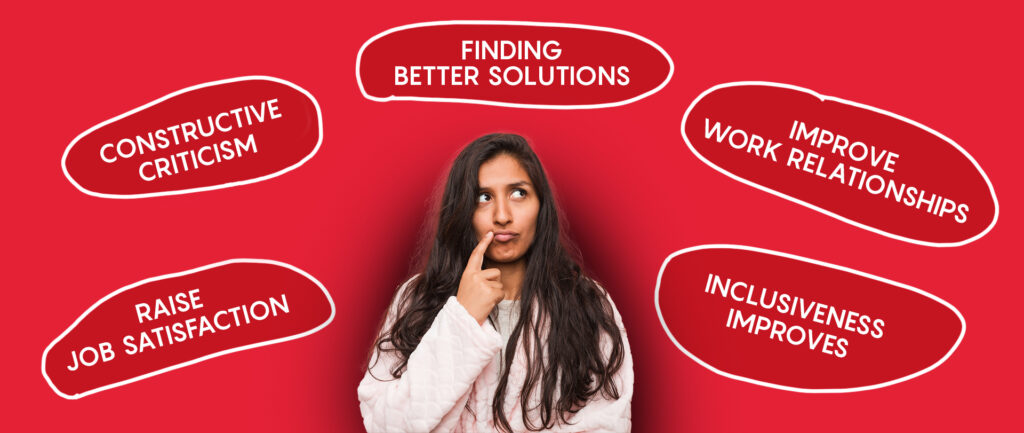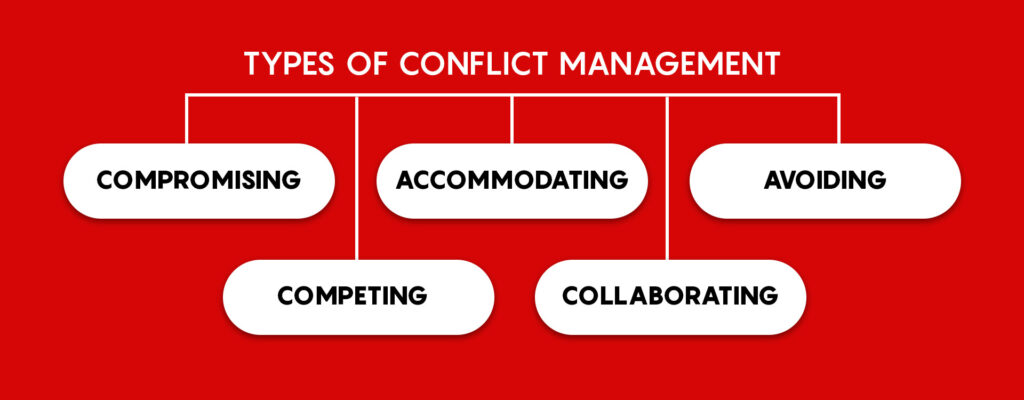It is true what science says about human behaviour – when it comes to conflict, we either respond with fight or flight. It is in our nature to respond on the toss of a coin. Most of the time, we do not even think about it, we just react. While this may be ideal in the grand scheme of what nature intended for our survival, it does not always work in the long run, especially in the workplace. What if science is wrong when it comes to the workplace? What if workplace conflict can be a good thing? Conflict management is the art of finding the middle ground in work-related conflict. Instead of trying to tackle the conflict to the ground and squash it, you might want to consider trying to use it to your benefit. Let us have a look at how it can be best navigated.
What Is Conflict Management To Begin With?
Conflict management is the art of resolution. It can take many forms and paths but the end goal is always the same – to minimise disputes and maximise efficiency within the workplace. There is a high demand for good management skills and interpersonal communication skills in conflict management because you are not so much commanding as you are mediating.
Now, conflict does not automatically mean that you have a negative work environment or that it is bad for the company by any means. Yes, in some cases things can get personal and very unhealthy but if you find that there is an individual pushing back against the norm it is usually because they feel there is a better way to work and that they are feeling unheard.
If your employees question the norm, it means you have a lot of proactive thinkers who are readily engaging the company on what should be. This is a good thing as it indicates that they feel confident enough to raise the issue in hopes of it getting solved.
‘‘
Conflict in the workplace does not necessarily have to be a bad thing. It can be a path to growth and mutual understanding.

How To Use Conflict To Your Advantage
The key to conflict management is to use in the right way. Workplace conflict can be a tool for productivity and innovation. Here are a few ways in which conflicts can be used efficiently:
Finding better solutions
Ever heard of healthy competition? When two or more people in an organisation are working on a certain project at the same level, each might have their own idea of what the best course of action may be. This will lead to creative differences and a drive to find the best approach. This process can expose the pros and cons of each approach and isolate the best option. Healthy competition essentially opens the door to exploring different avenues. The more ideas are explored and pursued the more innovation happens.
Constructive criticism
It is not always easy to hear someone challenge your ideas or give a less than positive feedback of your work. Instead of interpreting it as an offence, it is an opportunity to use that feedback to make improvements. Different people will have different views and that is a good thing. Seeing something through another’s perspective helps widen your horizons and this translates into a better quality of work.
Improve work relationships
Trial by fire tends to make people come together. You gain a newfound respect for the other person despite your differences. In order to find a common ground to stand on you first need to start from opposite ends of a certain opinion. Eventually it helps employees realise the bigger picture and self-resolution becomes an active part of the work atmosphere.
Job satisfaction levels rise
Back to the constructive criticism point from earlier. Once that mindset of accepting constructive criticism sets in, employees will no longer resent the friction that is bound to arise time and time again in the future. As long as they know that the management is looking out for them and keeping their interest at heart, they will not resent the conflicts that arise on a regular basis. The less the resentment, the more at ease they are in the workplace and the higher the job satisfaction levels will be.
Inclusivity becomes the new norm
Everyone wants to make their place of work a diverse environment these days, but diversity comes at a price. Different people are bound to have vastly different ideas and perspectives and this is sure to lead to friction. So, if diversity is truly a goal for your organisation, then be prepared for conflict. It falls to the manager to curate the conflict in such a way that it allows for growth and productivity. This is where conflict management plays the most important role – being a mediator.
A good example of how you could get a dialogue started to curate the conflict would be to hold weekly meetings for everyone. Do a thorough review, one-on-one, so that the employees are more willing to open up. After that, slowly transition into a group discussion, make everyone feel heard and suggest solutions.
When To Involve The Experts
Involving the HR
Most conflicts can be solved with a one-on-one discussion with the manager or with the person with whom there is an issue. Though there are some instances where even the manager will need some help resolving the situation. In those kinds of situations, the manager should involve HR into the conflict management process.
HR should get involved if the situation seems to be getting too personal and straying from the path of constructive criticism. Personal attacks, threats of harm, bullying and things of that nature are unacceptable in any work environment. This could lead to a drop in the morale of the organisation or even the employees quitting.
It should be noted that hiring is no easy task and takes a lot of time and money from the company’s side. In some extreme cases, the employee could resort to legal action which does not bode well for your organisation’s reputation. Once that respect is lost it is near impossible to gain back.
Involving a third-party
Sometimes, even HR needs help to reign in the conflict. There are many organisations and uniquely qualified individuals that can offer such services and help resolve the conflict on behalf of the company. This list of parties can include attorneys, mediators, motivational speakers and so on. It all depends on the situation at hand.
The most common instance where you would need an outside party is when the HR department lacks the time or training to handle a certain situation. This could include bullying, physical abuse and threat of severe legal action or recurring patterns of misdemeanour. In cases like that outside mediators could approach this from several different angles including workshops, talks, team-building activities or consultation. It all depends on their assessment of the situation.
Even though you have access to these kinds of solutions the point should be to try and resolve any and all conflict in-house. That is what the manager is there for, to navigate and understand where the common ground is. More than a manager they are a guide. Here are a few steps to take that will help guide employees to some sort of mutual understanding:
Establish the ground rules
Any conflict should be a controlled one in the workplace. Set up channels for employees to communicate their grievances through. Make it clear what is acceptable and what is not. Criticism and complaints are valid expressions but hate speech and abusive dialogue is not.
Get the dialogue going
Ask the employees involved to state clearly what their personal issues are and the changes they want to see in the work environment. Try to keep the conversation focused on the issue rather than on any one specific person. Avoid targeting at all costs.
Brainstorm solutions
Listening is a big part of this step. Everyone will have an opinion as to what can be the best solution and it is the mediator’s job to make sure everyone is heard. List out all the solutions and discuss with those concerned which one works best for them. If it is a feasible option for the company to implement in the long-run, then it is worth considering.
Resolution
Get the conflicting parties to shake hands or talk it out or apologise to each other. The point is to bury the hatchet and keep moving forward. Long-standing grudges do no one any good when it comes to work productivity.
‘‘
Conflict resolution can take many forms and it all depends on the scenario and your ability as a leader to read the situation.

Some Conflict Management Styles With Examples
Compromising
Finding the middle ground is often the best solution to conflicts. Both parties feel like they have been heard and their perspectives have been accepted to some capacity. It presents a situation of mutual understanding and builds working relationships. The only way it can be successful is when there is a mutual agreement on the solution. A forced compromise breeds resentment and becomes a redundant attempt at resolution.
Accommodation
This method is about knowing when to pick your battles and letting go where you can. Some issues are not worth so much effort that you have to stand and fight to be right every time. Sometimes it is okay to let go and let the other person have their way. This method is used if you want to avoid dragging out the conflict and you just want to maintain the peace. This is best used in scenarios where the issue is small and should be handled quickly.
A manager who utilises this method can be viewed as an easy-going person who is very approachable. This opens the door to more free dialogue and conflict resolution down the road.
Avoiding
It has less to do with ignoring the issue and more to do with giving everyone some breathing room when things get too heated. People can be reassigned to another project or department and teams can be shuffled. Whatever the move, it is good to ensure a cool-down period is in place so the situation can be revisited with clear heads.
This method should be used sparingly, however, as postponing the issue for too long can cause resentment to fester and cause more problems in the future.
Competing
No, it is not a competition to see who is more right. It is rather a practice of ruling with an iron fist. One side stands firm, usually the company or the management, and does not give way to others’ opinions or demands on account of there being no time or room in the present situation to try new things.
Change is always a necessity but not always a possibility. This method is great for shutting down conflicts quickly but morale and job satisfaction will take a hit.
Collaborating
Similar to compromising, this style focuses on getting all parties on the same page and working together to find a solution that works for everyone. The only difference is that in compromising both parties have to let go to a certain extent to find the middle-ground, whereas in collaborative resolutions, it is all about finding a solution where no one has to lose anything. It is more along the lines of trying to merge two perspectives into one so that the solution can be achieved.
Whatever the method you choose to implement, at the end of the day, it comes down to how good a leader you are. Read our article on ‘leadership’ to find out what it takes to be an exceptional leader.




